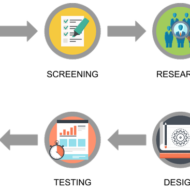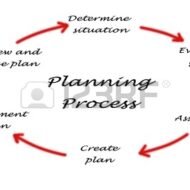Posted by Managementguru in Marketing, Principles of Management
on Mar 4th, 2014 | 0 comments

What Do You Mean by New Product Development? In business and engineering, new product development (NPD) is the complete process of bringing a new product to market. Innovate or Die: Product management should be viewed form a broader perspective by business firms, in that, it has to include new product development as part of the action plan, apart from appraising the existing product line, positioning them effectively and taking brand decisions wisely. “Innovate or die’, is the modern entrepreneurial slogan. Unless organizations innovate and introduce new products, they cannot survive in the competitive market. Strategies defining the organization’s future are built upon the portfolio of new products. Picture Cortesy: Coschedule Need for new product development: People always welcome change and new product development is an opportunity for the firms to meet the changes in consumer demands. They are a source of competitive advantage. Your new product may infuse a fresh lease of life to your sagging profits. New products may turn out to be the star performers of your firm and provide long term financial return on your investment. Some firms take the smart strategic choice of using the idle capacity of their plant for manufacture of a new product that may utilize the existing production and operation resources to an optimum level. They capitalize on research and development. Products that create a wave are a result of research on market trend and consumer preference. Firms can make it, if their research is customer-centric rather than product-centric. They provide opportunities for reinforcing or changing strategic direction. It is wiser to discontinue production of a product that does not find acceptance and divest the funds in a beneficial venture. They leverage marketing and brand equity. Big corporate firms while introducing new products make a big publicity, so that it can attract potential investors and consumers. They enhance the corporate image. You cannot expect a firm to make it big with a single product line or confined to one area of development. The growth of a company is evident only when it ventures into multifarious disciplines reflecting its capacity for expansion and diversification. Picture Courtesy: Staenz Also if a company grows, the growth of the stake holders is rest assured as the company would be in a position to offer decent dividends with bonus. Even if a growing company ploughs back its profits for expansion, it is again a good thing for the investors as further expansion obviously means growing profits. They affect human resources-a new product is perceived differently by different people. It is a need satisfying concept with benefit for buyers; a bundle of need satisfying features for marketers; a way to add value for intermediaries; an opportunity to design for R and D and a chance; to assemble and process for the production department. They meet environmental threats-Until recent times, products were not subjected to environmental evaluation, but the recent crises regarding global warming and pollution has been an eye opener for all nations which are enforcing much rules and regulations, demanding for production aimed at environmentally safe products. New product development is a multi-dimensional concept, inherent in most organizations. The process is initiated when the organizations are subject to market pressure and the firms are left with no choice other than to take up the challenge. A List of Productivity Terms Automation – The use of robots or other automatic equipment to do certain tasks Business Productivity – The amount of goods or services produced by a business from a set amount of resources Capital Goods – Manufactured or constructed items that are used...

Posted by Managementguru in Business Management, Organisational behaviour, Principles of Management
on Mar 2nd, 2014 | 0 comments

Nature of Organizational Planning What is Planning? “Planning is an intellectual process, the conscious determination of courses of action, and is a continuous process of decision making with built in flexibility.”- Herold Koonz and Weirich Planning is the most basic and primary of all management functions on the premise of which other functions evolve. It would be appropriate to compare planning to the basement or foundation of a building upon which the entire system rests. Planning bridges the gap from where we are to where we want to go. Planning involves selecting the best objectives and deciding on the suitable course of action. When we talk about planning, control is another entity that tags along like inseparable two-sides of a coin. Without planning there is no control and without control planning becomes meaningless. NATURE OF PLANNING: Prime function of management: Planning is the key to all other functions of management like organizing, leading, staffing and controlling. Is a continuous process: Plans need periodic review in the wake of external environment and internal resource potential and thus is a continuous process. Is an intellectual process: What is to be done, when, who and how are the very important questions that loom before a manager before making every decision. He has to use his intellect in order to make the right plans before acting. Is all pervasive: It penetrates right from the top to the bottom level of management, but it is the responsibility of the managers or executives at the top level to make the right moves at the right time. Is flexible: One has to understand that flexibility is restricted when it comes to irretrievable costs already incurred in fixed assets, training, advertising etc. Is goal oriented: Planning starts with setting up of objectives and completely goal oriented. TYPES OF PLANS: Purpose or Missions: Basic task of an organization. For example, teaching and research can be attributed as the basic function of an educational institution; the purpose of business is to produce, distribute goods and make a surplus. Objectives: These are the goals that have to be accomplished by the organization. Corporate companies chart out their production plan well in advance to meet the requirements on time. For this they break the objectives into short term goals i.e., for a quarter based on the sales forecast. This kind of planning gives clarity and direction for the production team to achieve the goals. Strategies: These are the set of action plans designed in order to achieve the future objectives backed up by long term perspective in the wake of environmental analysis and give direction in which the resources have to be channelized. Policies: These are basically the guideline books that direct the course of the organization’s function as what to do and what not to-do. They see to that the decisions made fall well within certain boundaries in order to ensure fair and equitable treatment to all the employees. HR policies govern all the functions related to pay, promotion and other disciplinary mechanisms related to the work force. Procedures: They are programmes designed to carry out the activities of the organization in a specified manner. The procedures for placing a purchase order, payment collection etc., Programmes: A programme is the sum total of goals, policies, procedures, rules, task etc., For example, new product development may be cited as a major programme while promotional campaign may be cited as a supporting programme. Budget: No plan is feasible without a budget allocated to it. A budget is a numberised programme and more of a control device. Revenue budgets, expense budgets, production budgets to name a few. Zero base budget: This kind of budget does not take into account the previous year’s performance record or budget but treats every progarmme afresh and starts working from ground up. Each programme is treated as a separate...

Posted by Managementguru in Economics, International Business
on Feb 16th, 2014 | 0 comments

Economic Growth Strategies A Purview on Economic Growth Strategies for Developing Countries A developing country is one where the per capita income is low relative to that of fully developed countries. In human terms developing countries typically have major population percentage with poor health, low levels of literacy, inadequate dwellings and meager diets. The key to development rests on four fundamental factors namely human resources, natural resources, capital formation and technology. Human resources: A lot of poor countries are forever running hard just to stay in place. Even as a developing nation’s GDP rises, so does its population. So it becomes a mammoth task for such nations to overcome poverty with birth rates so high. Equitable distribution of wealth cannot happen in an economy unless and until it becomes self sufficient. One strategy will be to curb the population, even if such actions run against prevailing religious norms. Strategies for Developement Economic planners in developing countries lay great emphasis on the following strategies of development with regard to human capital: Control disease and improve health and nutrition Improve education, reduce illiteracy and train workers Above all, do not underestimate the importance of human resources. Literate people are knowledgeable and resourceful; their analytical skills help them to weigh the pros and cons of specific social situations that affect their standards of living. Asian countries like India and China with exploding population figures are in a situation to invest their human capital for productive purposes. Pinning Your Way to Profit With Pinterest Natural Resources: Some developing nations with meager endowments of natural resources such as land and minerals have to divide the available resources among the dense population. Perhaps the most valuable of all the resources would be arable land, as most of the people in developing countries employ themselves in farming, which is the primary economic activity. Hence the productive use of land with appropriate conservation, fertilizers and tillage will go- far in increasing a poor nation’s output. More over land ownership patterns are a key to providing farmers with strong incentives to invest in capital land’s yield. When farmers own land, they are more willing to make improvements, such as irrigation systems and undertake appropriate conservation practices. The governments have to think in these lines if their economy is based on agricultural activity: Farmers should be appraised about modern farming techniques and provided with farming equipments and fertilizers at subsidized rates. Note:-nothing should be given as free as freebies make them lethargic and unmotivated. Much of cultivable lands are being destroyed for commercial purposes which have to be checked. Power generation and supply should be copious and uninterrupted as farming, solely is dependent on availability and usage of ground water. Pumping of water is done through jet pumps and electric motors. Budding population can make a marked difference in the field of farming, as it is impossible for a nation to generate white collar jobs for everyone and it definitely elevates the capacity of youth from being mere employees to that of owners. Organic farming has found a place for itself in international market and human capital of developing nations can be employed in research and development of new strains that will facilitate to capture the global market. Capital formation: Rates of productive capital formation are low in developing countries because of deprived income; little can be saved for the future. The financing of growth in poor countries has always been an unstable link in the productive mechanism. Countries should definitely have a balanced and cautious approach when they plan to finance ambitious development programmes as they will be forced to borrow heavily from other developed countries or the World Bank. Technological change and innovations: This is...






